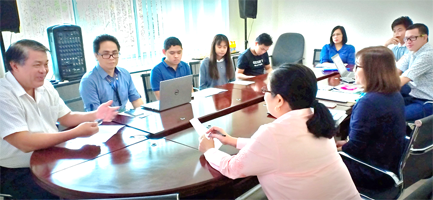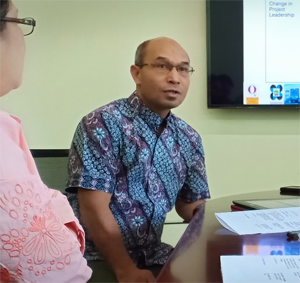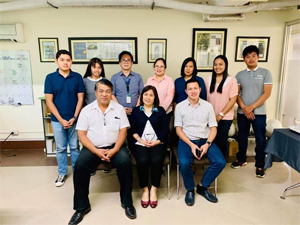 A project explores Amaranthus spinosus as a potential dietary protein for tilapia. The project, funded by the Philippine Council for Agriculture, Aquatic and Natural Resources Research and Development of the Department of Science and Technology (DOST-PCAARRD), is being implemented by the Isabela State University (ISU) and the University of San Carlos (USC).
A project explores Amaranthus spinosus as a potential dietary protein for tilapia. The project, funded by the Philippine Council for Agriculture, Aquatic and Natural Resources Research and Development of the Department of Science and Technology (DOST-PCAARRD), is being implemented by the Isabela State University (ISU) and the University of San Carlos (USC).
Amaranthus spinosus is a shrub with thorny branches and cluster of flowers. It is also known as ‘spiny amaranth,’ or ‘pigweed’ in English and called locally as ‘uray.’
 A meeting of the project titled “Amaranthus spinosus Leaf Meal as Potential Protein Source for Nile Tilapia” was conducted on February 12, 2019 and was led by the monitoring team, Inland Aquatic Resources Research Division (IARRD) of PCAARRD. The team is headed by Dr. Adelaida T. Calpe, R&D Monitoring and Evaluation Unit Head.
A meeting of the project titled “Amaranthus spinosus Leaf Meal as Potential Protein Source for Nile Tilapia” was conducted on February 12, 2019 and was led by the monitoring team, Inland Aquatic Resources Research Division (IARRD) of PCAARRD. The team is headed by Dr. Adelaida T. Calpe, R&D Monitoring and Evaluation Unit Head.
According to USC Vice President for Academic Affairs Alexander Gaut, the advancement of societies is research driven and that there are challenges faced by the society that Filipinos could answer. He added that researchers have to be keen in choosing areas of research to answer these challenges.
ISU Project Leader Dr. Isagani P. Angeles, Jr. highlighted the accomplishments of the project which include the collection and plantation of Amaranthus spinosus, preparation of the experimental setup, conditioning of the Nile tilapia, and the preparation of the experimental diets.
 USC Project Staff Dr. Jonie C. Yee also presented the accomplishments of the project which include the identification of laboratories and facilities involved in the project implementation, collection and extraction of Amaranthus spinosus leaves, and initial phytochemical screening of the samples. Initial analyses revealed a positive result for the presence of terpenoids and steroids in Amaranthus, which could be used to enhance the growth of tilapia due to the presence of anti-estrogen components.
USC Project Staff Dr. Jonie C. Yee also presented the accomplishments of the project which include the identification of laboratories and facilities involved in the project implementation, collection and extraction of Amaranthus spinosus leaves, and initial phytochemical screening of the samples. Initial analyses revealed a positive result for the presence of terpenoids and steroids in Amaranthus, which could be used to enhance the growth of tilapia due to the presence of anti-estrogen components.
The PCAARRD and ISU teams also visited the Microbiology and Biomaterials Laboratories in Arnoldus Science Complex, USC which are involved in the project implementation.
